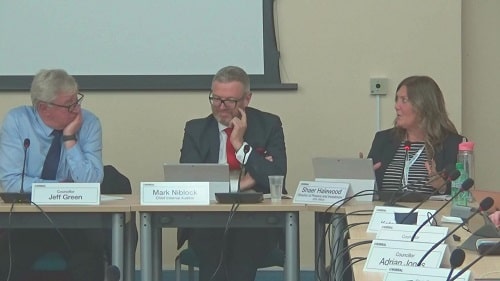Wirral Council’s auditors Grant Thornton issue adverse value for money conclusion on 2019–20 accounts
By John Brace (Editor) and Leonora Brace (Co-Editor)
First publication date: 11th January 2021, 11:51 (GMT)

Tonight (11th January 2021) Wirral Council’s Audit and Risk Management Committee meets to agree to both its own accounts for 2019–20 and that of the Merseyside Pension Fund (Wirral Council is the Administering Authority for the Merseyside Pension Fund). The legal deadline for final audited local council accounts for 2019-20 was put back to the end of November 2020 because of the pandemic but Wirral Council is set to approve its accounts for 2019-20 considerably later than this deadline.
Wirral Council’s auditors Grant Thornton on page 5 of their report in their determination of whether Wirral Council “has made proper arrangements to secure economy, efficiency and effectiveness in its use of resources” which is known as “the value for money (VFM) conclusion” has determined for the 2019–20 financial year that Wirral Council have not made proper value for money arrangements. Their report states, “We have concluded that Wirral Council does not have proper arrangements to secure economy, efficiency and effectiveness in its use of resources. We therefore anticipate issuing an adverse value for money conclusion”.
Later in their report, Wirral Council’s auditors point out that the 2019-20 Revenue Budget included £7 million from the flexible use of capital receipts (generally the sale of land and buildings), but there were warnings from Wirral Council’s auditors three years ago that the use of one-off amounts from capital receipts to support Wirral Council’s Revenue budget was not financially sustainable.
An example of a capital receipt that Wirral Council may receive is the proposed £820,000 from the controversial sale of land in Upton to Lidl for a supermarket. At the time of writing 990 people have signed a petition of opposition to the sale and the consultation period for objections to the sale of the land closed last Friday (8th January 2021).
Wirral Council is at the time of writing is also consulting on its 2021–22 Budget, one of the proposals for the 2021–22 Budget is to close Europa Pools which has attracted a petition of objection of 3,835 people at the time of writing.
The public meeting of Wirral Council’s Audit and Risk Management Committee can be watched at this link. The papers for the public meeting can be read on Wirral Council’s website.
If you click on any of the buttons below, you’ll be doing me a favour by sharing this article with other people.

I believe roughly 11% of every single Wirral Council Tax payer’s personal council tax demand is used to prop up a hidden debt of £295 million in LOBO loan debt to foreign banks with outposts based in London. But if you read the Wirral Globe and the Liverpool Echo, listen to or watch the northwest news, you wouldn’t know. A further large percentage is used to fund the pensions of council staff, but the media, feigning impartiality but in reality being captured and controlled, don’t tend to dwell on such awkward matters.
Thanks for your comment Paul.
The draft Statement of Accounts for Wirral Council for 2019-20 show LOBO loans valued at £202.8 million (fair value) or £102.3 million (carrying amount). So is your figure of £295 million for LOBO loans from a previous year or using a different valuation method?
The issue of pension liabilities was discussed at the meeting of the Audit and Risk Management Committee but the issue of LOBO loans wasn’t.
Large amounts of what Wirral Council collect in council tax also are not spent by it directly but go to Merseyside Fire and Rescue Authority/Merseyside Fire and Rescue Service, Merseyside Police/Office of the Police and Crime Commissioner for Merseyside, Merseytravel/Liverpool City Region Combined Authority and Merseyside Waste Disposal Authority (known as Merseyside Recycling and Waste Authority). Didn’t there used to be a leaflet sent out by Wirral Council each year with pie charts with the annual council tax demands showing the relative amounts spent on each area?
Thanks John, that’s the original fair value amount (fair?!) before the Barclays(?) portion was settled. My bad. We only owe £202 million and if we keep procreating, our grandchildren will step in and settle it for us in 2078 – the 200th anniversary of the founding of Everton Football Club. Cheers.
Well done Paul, i suppose the 80% of our tax goes towards paying wages, leaving around 7% to run the place.
I have a street light outside my home, it hasn’t worked since July last year, reported it a number of times, just ignored, and yet the lights in the rest of the road were replaced by those awful LED’s, so the council has money to spend and waste!
There are university studies accurately stating that LED white light is actually blue and situated uncomfortably close to harmful ultraviolet on the visual spectrum. They also claim that macular degeneration and retinal damage could result in humans and wildlife due to prolonged exposure. You could be safer staying locked down, with that light permanently off !
Thanks for your comment Paul.
The reason why the old streetlights are being replaced with the LED ones is that the new LED ones are cheaper on running costs as they need less electricity.
Surely if there was the impact you suggest, this would have been assessed before the project replacing the existing streetlights was started?
Oh John, how open and trusting you are for a hard-bitten journalist. When the projections suggest you’re likely to cut your future electricity costs by half, the small matter of blinding humanity doesn’t get a look in.
Thanks for that comment Paul.
I forgot to mention that Wirral Council borrowed the money for the new LED streetlights from Salix Finance (the money for the loan from Salix Finance ultimately comes from the Department of Business, Energy and Industrial Strategy). Further information on it is here. So it’s back to the topic of borrowed money again!
Thanks for your comment keef666.
The pie chart on page 9 for this year (2020-21) shows that Wirral Council planned to spend 19% of its budget on employees.
As to street lights, does anyone know if Wirral Council are not repairing the faulty street lights if they are the old sort of streetlights that Wirral Council plan to replace soon with a LED one instead?
John, when I was a lighting designer, I knew these new LED lamps / lanterns would have been required to satisfy the BS5489 British Standard, with lampposts spaced to give the illuminance levels needed for safe roads. But Wirral Council are replacing them like for like and the safety issue here is that there are now hundreds, possibly thousands of dark patches created. Pedestrians – who don’t tend to wear reflective clothing – will be killed and injured as a result. There is a ticking time bomb been set, all thanks to whichever councillors and senior officers signed this one off. In the past I would have told Green Councillor Pat Cleary, but since he started appearing on the GAGGING / PAYING OFF Employment & Appointments Committee, I’ve written him off … naturally
Hi Paul,
British Standard 5459-1:2020 got changed last year – see here for a list of some of the changes which include recommendations on energy efficiency. As Wirral Council is part of the Merseyside Road Safety Partnership (whose aim is to reduce the numbers killed or seriously injured on the roads) why would Wirral Council do something that would lead to a greater chance of accidents?
Further to this John, the question here for Wirral’s councillors and senior officers was a multi-faceted, economic one. Do we invest £millions undertaking safe street lighting designs which would entail the massive extra cost of removing thousands of old, redundant lampposts and lanterns, and installing new ones, but would provide safe streets for traffic and pedestrians? Or do we ignore the British Standard, cut corners, avoid having to switch off street lights at night, save £millions and accept that men, women and children are going to be killed and injured?
Another pertinent question would be: did Wirral Council still have the staff or the control of the staff qualified to carry out the design work, after allowing the last chief lighting designer / Group Leader to retire and outsourcing the lighting design section to a private company?
Google: WIRRAL COUNCIL SWITCHES OFF HUNDREDS OF STREET LIGHTS, BUT WITHOUT CONSIDERING ALL THE INFORMATION
Thanks Paul,
As mentioned in answer to an earlier comment, the relevant British Standard you refer to was changed last year.
And here are the changes to that British Standard in detail. Highly technical stuff here. Take it from me, John, there is absolutely nothing touched upon here to justify cutting corners at the expense of public safety, but Wirral Council have steamrollered their way through regardless… by fitting new LED lanterns to old lighting positions, lanterns which have not undergone any design or spacing adjustments. It’s “FIRE AND FORGET”. They’ve created poorly lit areas and invited foreseeable and avoidable danger to the public, as has become their accustomed practice.
https://indolighting.com/bs-5489-2020-changes/
What happened to Public Accounts CommittteE or any accountability ?